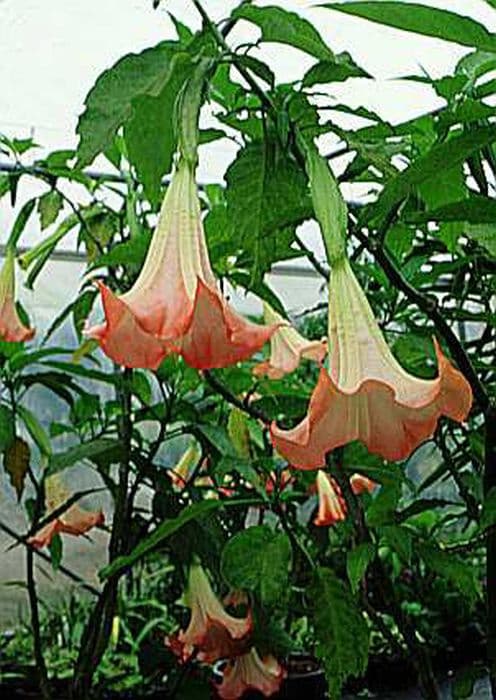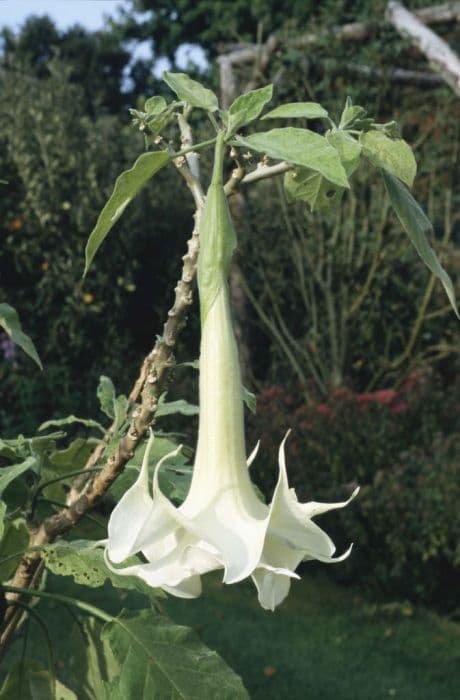Million Bells Calibrachoa Aloha Classic Blue Sky (Aloha Classic Series)
![calibrachoa [Aloha Classic Blue Sky]](/_next/image?url=https%3A%2F%2Fplants-admin.emdemapps.com%2Fimages%2Fplants%2F%2Fimages%2F604b636c3778b.png&w=3840&q=75)
ABOUT
The Calibrachoa Aloha Classic Blue Sky, part of the Aloha Classic Series, is a stunning, prolific bloomer with petite, trumpet-shaped flowers. The blossoms appear in a remarkable shade of sky blue, which gives the plant its name and is reminiscent of a clear summer's day. They often feature a delicate yellow center, providing a beautiful contrast against the cool-toned petals. Surrounding the flowers are small, green leaves that create a lush backdrop for the floral display. The foliage has a slightly cascading habit, which adds to the overall soft and trailing appearance of the plant. This feature makes it ideal for hanging baskets or as spilling foliage over the edges of containers. The vivid and abundant flowers create a captivating and continuous color spectacle throughout its growing season, which adds charm to any garden or outdoor space.
About this plant
 Names
NamesFamily
Solanaceae
Synonyms
Million Bells, Mini Petunia
Common names
Calibrachoa Aloha Classic Blue Sky
 Toxicity
ToxicityTo humans
Calibrachoa is not known to be toxic to humans. Ingesting parts of the plant is unlikely to cause any serious symptoms of poisoning. However, it is generally advised that any plant material not meant for consumption should be kept out of reach of children who might accidentally ingest it as a precaution.
To pets
Calibrachoa is not known to be toxic to pets such as dogs and cats. Similar to humans, ingestion of this plant is unlikely to result in serious poisoning or symptoms. However, gastrointestinal upset could occur if pets consume a large amount of the plant. It's always wise to monitor pets and prevent them from eating plants not intended for consumption, as individual reactions can vary.
 Characteristics
CharacteristicsLife cycle
Annuals
Foliage type
Evergreen
Color of leaves
Green
Flower color
Blue
Height
6-10 inches (15-25 cm)
Spread
12-24 inches (30-61 cm)
Plant type
Herb
Hardiness zones
9
Native area
South America
Benefits
 General Benefits
General Benefits- Compact Growth: Calibrachoa is known for maintaining a neat, compact shape without becoming leggy, making it excellent for container gardening.
- Long Blooming: This plant provides colorful blooms from spring until fall, ensuring a long-lasting display of color in the garden.
- Attracts Pollinators: With its abundant flowers, the Calibrachoa is attractive to butterflies and hummingbirds, promoting pollination in the garden.
- Low Maintenance: It requires minimal upkeep, making it ideal for gardeners of all skill levels and those with limited time for gardening.
- Drought Tolerant: Once established, Calibrachoa is relatively drought tolerant, reducing the need for constant watering.
- Versatile Use: It's perfect for hanging baskets, window boxes, and as a spiller plant in mixed container plantings.
- Vibrant Colors: Calibrachoa comes in a variety of colors, with the 'Blue Sky' variety offering unique and striking blue-toned flowers.
- Fast Growing: It's a quick grower, allowing gardeners to enjoy its fullness and blooms shortly after planting.
 Medical Properties
Medical PropertiesThis plant is not used for medical purposes.
 Air-purifying Qualities
Air-purifying QualitiesThis plant is not specifically known for air purifying qualities.
 Other Uses
Other Uses- Photography Backdrop: The Calibrachoa's vibrant colors can add a natural and beautiful background for macro or portrait photography sessions.
- Educational Tool: Horticulture educators can use the Calibrachoa as a live example to teach students about hybridization and plant breeding methods.
- Artistic Inspiration: Artists may find the rich hues and delicate shapes of Calibrachoa flowers inspiring for their paintings, drawings, or textile designs.
- Fairy Gardens: Ideal for creating enchanting scenes in miniature fairy gardens due to their small size and colorful appearance.
- Aquarium Landscaping: Although not an aquatic plant, Calibrachoa can be used in terrarium-like setups that accompany an aquarium to create a cohesive natural landscape.
- Scented Gardens: While the Calibrachoa itself is not known for a strong scent, it can contribute to a multi-sensory garden experience when paired with aromatic herbs.
- Creative Containers: Use the Calibrachoa in unconventional container gardens like repurposed items (old shoes, kitchenware, etc.) for a unique aesthetic.
- Pet Photography Props: Calibrachoa plants can be used as safe and colorful props in pet photography to add a splash of color.
- Color Therapy: The bright and uplifting colors of the Calibrachoa can be integrated into color therapy sessions for psychological well-being.
- Stop-motion Animation: The incremental growth and change in Calibrachoa blossoms can be captured in stop-motion videos to show the beauty of plant development.
Interesting Facts
 Feng Shui
Feng ShuiThe Calibrachoa is not used in Feng Shui practice.
 Zodiac Sign Compitability
Zodiac Sign CompitabilityThe Calibrachoa is not used in astrology practice.
 Plant Symbolism
Plant Symbolism- Relaxation: The calming blue hue of the Calibrachoa is often associated with tranquility and peacefulness, evoking the feeling of a clear sky.
- Inspiration: Blue flowers are symbolic of inspiration and creativity, suggesting the limitless possibilities of the sky above.
- Trust and Loyalty: Blue is a color often linked to trustworthiness and loyalty, which can be attributed to the dependable blooming of this plant.
- Intimacy: Small, elegant flowers like those of the Calibrachoa can symbolize close-knit relationships and the beauty of shared spaces.
 Water
WaterMillion Bells should be watered thoroughly, allowing the top inch of soil to dry out between waterings. They typically need water every few days, but this can vary based on temperature and humidity. A good approach is to check the soil moisture every other day and water when necessary. During hot summer days, they may need daily watering. Provide approximately 16 ounces of water for small pots or up to 1 gallon for larger containers every time you water, ensuring even saturation.
 Light
LightMillion Bells thrive in full sun to partial shade. They do best when they receive at least 6 hours of direct sunlight a day. Place them in a spot where they will be exposed to morning sunlight and get some afternoon shade, particularly in very hot climates.
 Temperature
TemperatureMillion Bells prefer temperatures between 55 and 85 degrees Fahrenheit. They can tolerate a minimum temperature of around 50 degrees Fahrenheit at night and maximum daytime temperatures up to around 90 degrees Fahrenheit. However, consistently high temperatures above this range can stress the plant.
 Pruning
PruningMillion Bells should be pruned to encourage bushiness and to remove spent flowers, which promotes continuous blooming. Lightly prune or pinch back the stems every few weeks during the growing season. The best time to prune is in late winter or early spring before new growth begins.
 Cleaning
CleaningAs needed
 Soil
SoilMillion Bells thrive in a well-draining soil mix with a pH between 5.5 and 6.5. An ideal soil recipe would include a mix of peat moss, perlite, and compost to ensure good aeration and moisture retention. Regular feeding with a balanced, water-soluble fertilizer will support healthy growth.
 Repotting
RepottingMillion Bells should typically be repotted every year to replenish the soil. However, since they are often grown as annuals, repotting can also coincide with replacing the plant each season. Ensure the new pot is only slightly larger than the previous one.
 Humidity & Misting
Humidity & MistingMillion Bells prefer moderate to high humidity levels but are quite adaptable. They perform well in typical outdoor humidity but can also tolerate lower humidity levels without significant issues.
 Suitable locations
Suitable locationsIndoor
Place Million Bells in bright, indirect light indoors with good air circulation.
Outdoor
Grow Million Bells in a sunny spot with afternoon shade and shelter from wind.
Hardiness zone
9-11 USDA
 Life cycle
Life cycleCalibrachoa, commonly known as Million Bells, begins its life cycle as a seed where, after germination, it develops roots and a shoot that emerges from the soil. The seedling grows into a vegetative state characterized by robust leaf growth, establishing a strong root system and stem development. The plant then enters a flowering phase, triggered by appropriate light and temperature conditions, producing the distinctive blue-violet blooms of the 'Aloha Classic Blue Sky'. After pollination, often facilitated by insects, the flowers develop into seed capsules containing numerous tiny seeds, which when mature, are dispersed by wind or other means. If not deadheaded and if growing conditions permit, Calibrachoa will continue to flower over an extended period, often from spring until the first frost in temperate climates. Following seed dispersal, and as seasonal conditions become less favorable, the plant enters senescence, where growth slows and it may eventually die, although many Calibrachoa varieties are perennial in warmer climates or can be overwintered indoors in colder regions.
 Propogation
PropogationPropogation time
Spring to Summer
The most popular method of propagation for the Calibrachoa, commonly known as million bells, is through softwood cuttings. This is typically done in spring to early summer when the plant's new growth is just maturing and semi-ripe. A cutting of about 4 to 6 inches (10 to 15 cm) should be taken just below a node and ideally should have a few leaves. The lower end of the cutting is then dipped in rooting hormone powder to encourage root development and planted in a well-draining soil mix. The cutting should be kept under high humidity, either by covering it with a plastic bag or placing it in a propagation chamber, and kept in indirect sunlight until roots have developed, which often takes a few weeks. Once the plant has a robust root system, it can be transplanted into a larger pot or into the garden.


![Calibrachoa [Aloha Classic Gold]](/_next/image?url=https%3A%2F%2Fplants-admin.emdemapps.com%2Fimages%2Fplants%2F%2Fimages%2F604b6284c573e.png&w=640&q=75)
![Calibrachoa [Aloha Classic Tiki Soft Pink]](/_next/image?url=https%3A%2F%2Fplants-admin.emdemapps.com%2Fimages%2Fplants%2F%2Fimages%2F604b548e0a5ef.png&w=640&q=75)
![Calibrachoa [Cabaret Deep Yellow]](/_next/image?url=https%3A%2F%2Fplants-admin.emdemapps.com%2Fimages%2Fplants%2F%2Fimages%2F604b5f20ca3ef.png&w=640&q=75)
![Calibrachoa [Calibasket Radiant Orange]](/_next/image?url=https%3A%2F%2Fplants-admin.emdemapps.com%2Fimages%2Fplants%2F%2Fimages%2F604b536d43cb2.png&w=640&q=75)
![Calibrachoa [Caloha Classic Blue Velvet]](/_next/image?url=https%3A%2F%2Fplants-admin.emdemapps.com%2Fimages%2Fplants%2F%2Fimages%2F604b604884a75.png&w=640&q=75)
![Calibrachoa [Caloha Classic Honey White]](/_next/image?url=https%3A%2F%2Fplants-admin.emdemapps.com%2Fimages%2Fplants%2F%2Fimages%2F604b5f56e0beb.png&w=640&q=75)
![Calibrachoa [Caloha Classic Yellow Chocolate Ring]](/_next/image?url=https%3A%2F%2Fplants-admin.emdemapps.com%2Fimages%2Fplants%2F%2Fimages%2F604b538aede95.png&w=640&q=75)
![Calibrachoa [Caloha Grand Purple]](/_next/image?url=https%3A%2F%2Fplants-admin.emdemapps.com%2Fimages%2Fplants%2F%2Fimages%2F604b6192993d2.png&w=640&q=75)